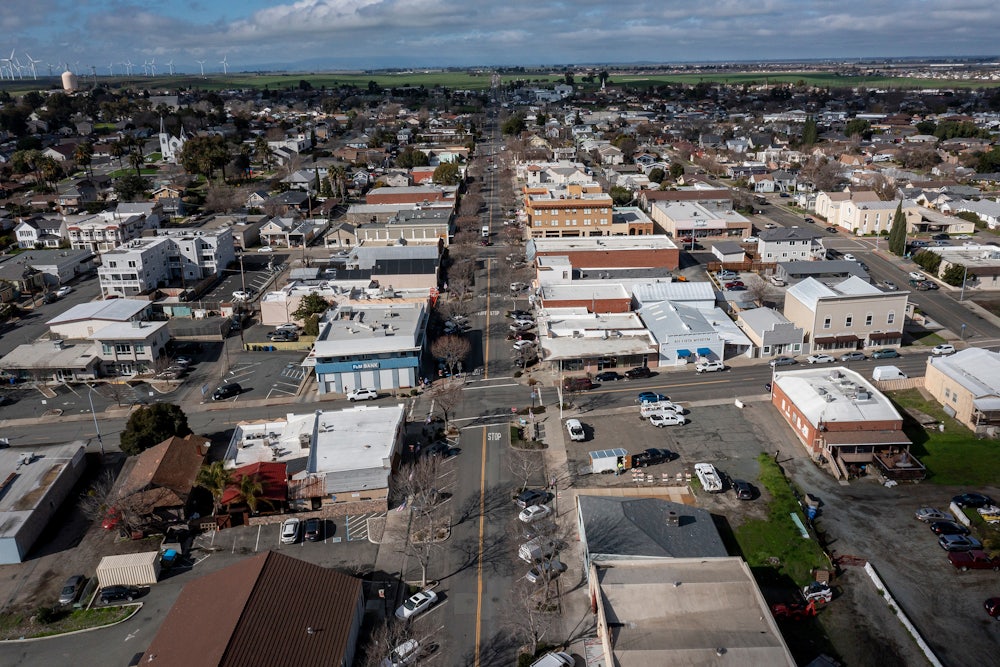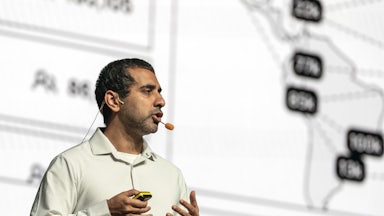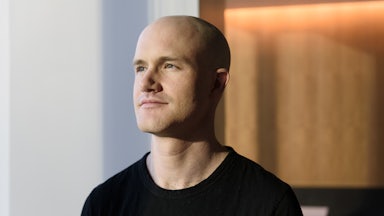Tech bros love to repackage old ideas as innovation. We’ve all seen it. But their latest foray into disruption no one else wants, the so-called “network state” and its constellation of start-up cities, deserves our attention. This notion has been embraced by President Donald Trump, who has rechristened them “freedom cities.” In reality, the scheme is a techno-fascist vision of the future that’s been quietly but persistently pushed and funded by billionaires such as Peter Thiel, Marc Andreessen, Brian Armstrong, and Sam Altman for years. Despite the shiny marketing materials for places like Próspera and California Forever, which make outlandish promises of futuristic utopias, the start-up city as a concept is a modern, ketamine-infused repackaging of something that flopped into obsolescence long ago: the company town.
And I would know. I grew up in a coal-mining town in Southwestern Wyoming and compiled an oral history of the place called Out Here On Our Own. I talked to multiple people who grew up in the old coal camps where one company owned and controlled everything. The surveillance, the practice of paying workers in dubious currency (commonly referred to as “scrip”), and the ultimate goal of creating small fiefdoms for company masters—it’s all been done, and to horrific effect. From staggering rates of suicide and addiction to a constant sense of fear among citizens, the trauma of living in a company town cascades through generations.
The company town framework gained steam during the Industrial Revolution. Pullman, Illinois, is a notorious American example. George Pullman, who owned Pullman Palace Car Company, forced people to work interminable hours in unforgiving factory conditions, and he paid them in scrip that was worthless outside his own stores. In 1893, Pullman cut workers’ wages by 25 percent without lowering rent on their homes—not to mention the grocery prices in those same company stores—which led to fierce labor organization efforts and the bloodiest strike America had seen.
The Pullman strike showed the world that the company town was a doomed experiment in human control. But the industrialists of the time were every bit as hubristic as today’s tech oligarchs. They saw Pullman as a barometer for how much cruelty workers would endure before revolting. The profit margins were too enticing to abandon the model altogether, so company owners built fiefdoms across the country, albeit in slightly less extreme forms. The end result was always the same: worker organization—and often violent revolt.
Coal, steel, and lumber companies set up camps and towns across the West based on where those resources were abundant, not where people wanted to live. My hometown, Rock Springs, is a paragon of that phenomenon. It’s a windy, barren, and often frigid place that never would’ve been colonized and developed as somewhere to live were it not for its surfeit of coal.
Coal jutted from the hills and badlands in the area. Union Pacific, or UP, didn’t hesitate to lay tracks, dig mines, and set up a network of mining camps. By the early 1900s, Rock Springs grew into a proper town that was, for all intents and purposes, owned by Union Pacific. The company built shoddy housing with paper-thin walls for workers who toiled in mines where they were as likely to get mangled by runaway pit cars as they were to die in cave-ins or explosions. One former resident recalled visiting his uncle in company housing: “The UP coal houses were stark. They were clapboard, and I remember the linoleum being all worn out. The lighting was simply a bare bulb hanging from the ceiling.” Meanwhile, Union Pacific Coal raked in a fortune.
Then, as now, my hometown had crushing rates of addiction and suicide. With miners regularly dying at work, the experience of living there was defined for many by despair. As if that wasn’t enough, Union Pacific evicted families from their meager homes whenever miners got killed. Former inhabitant Les Georgis told me about an explosion near Rock Springs that killed several miners. Following a mass funeral, where “the miners were laid out like cordwood,” Union Pacific evicted surviving family members from their homes, leaving them to fend for themselves.
“My wife’s grandma had been living in a coal camp house, and she had a little baby,” Georgis said. “The coal company told her that, since her husband wasn’t around to work the mine anymore, she had to move out. They put all her stuff out on the street. I knew another family that happened to as well.” Such cruelty combined with harsh conditions in the mines to push miners to organize and strike.
Union Pacific’s desire to own and operate coal mines deflated when the train company switched to diesel engines, but Rock Springs and its satellite settlements still relied on coal mining. Union Pacific shuttered its mines with no concern for how people would survive. Other coal companies had moved in over the years, but UP closing its mines was a massive blow. The company simply boarded them up and left. Abandoned mines caused subsidence in neighborhoods where houses warped and sank, but what did Union Pacific care?
Growing up in a mining town, and the conversations I had with multiple generations of residents, made it clear to me that it’s a colossal mistake to allow companies and investment groups to build towns where they’re free to do as they please. There have been efforts over the years to prevent company towns from forming again, but that hasn’t stopped corporations like Amazon, Google, and Meta from flirting heavily with the concept.
The network state movement goes well beyond those prior flirtations: It seeks to form a collection of corporately owned charter cities where regulation doesn’t exist. This idea started gaining momentum with the publication of Silicon Valley gadabout Balaji Srinivasan’s book, The Network State, which put him firmly in the company of those tech barons who’ve made democracy itself a target of their ire.
Srinivasan argues that nation-states are dying and should be replaced with a global collection of corporately controlled enclaves, each functioning as its own de facto country. In his view, we should dismantle and replace countries like the United States, as engineers would an outmoded piece of software. Seen by tech fascists as an appealing alternative to democracy, the network state is the company town framework on a cocktail of steroids, ketamine, and life-extending placebos. Rebranded as freedom cities, this sophomoric thought experiment has been given the green light by Trump.
But for the call to disrupt democracy, this movement has few, if any, new ideas. A direct callback to the use of scrip in company towns, cryptocurrency is a key component of freedom cities. One function of unregulated scrip in places like Pullman was to further ensnare workers by controlling their spending power and ability to leave. Paying workers in crypto coins, each of which is highly mercurial and vulnerable to scams and price manipulation, would provide similar levers for control. (It’s worth noting that Amazon uses Swag Bucks, its own version of scrip, to reward high-performing employees, despite scrip becoming illegal in 1938.)
What’s truly disturbing is how far along the network state movement has gotten. Located off the coast of Honduras, a start-up city called Próspera hosts medical facilities that are free to explore genetic experiments with abandon. According to The New York Times, a construction worker died building Próspera. He fell to his death during a blackout. In northern California, a real estate coalition dubbed California Forever seeks to create its own city that local residents fear will buy up all the land, clog roads, and pollute their skies. Elon Musk’s SpaceX owns Starbase, Texas, where workers are routinely put in harm’s way and, of course, filed into company housing.
The conditions of Musk’s prefabricated homes are obviously better than the old coal camp houses, but there’s still the question of what would happen to an employee’s family if they got fired, debilitatingly injured, or killed on the job, especially in the face of eroded regulation and a CEO who thinks empathy is weak. As with company towns, where spying was a common tool to crush dissent and disrupt collective action, each of these start-up cities is, or will be, subject to relentless surveillance.
Representative democracy has always been the enemy of plutocrats like George Pullman, Peter Thiel, Brian Armstrong, and now Elon Musk. Whether you call it a company town or a freedom city, the goal is the same: to foster a fascistic version of capitalism where company owners are free to explore the depths of their greed and sadism. But as Trump allows such ghouls to form their so-called freedom cities, those of us who’ve learned from human history will do well to recall that this has all been tried before—and remember the Pullman strike.
* This article has been updated.










